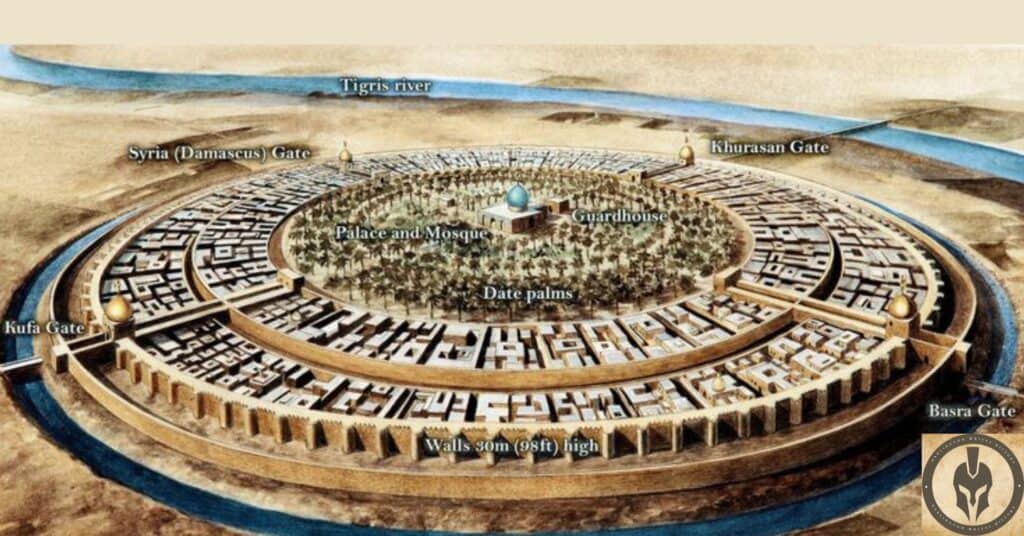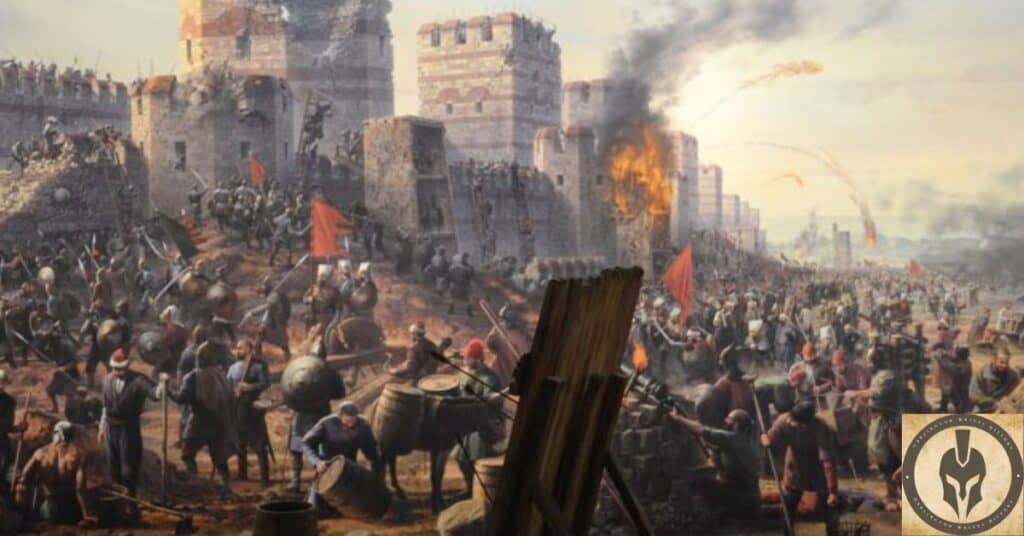In 1258, the world witnessed the catastrophic sack of Baghdad, where “the waters of the Tigris ran black with ink and red with blood,” marking the end of the Islamic Golden Age. This momentous event obliterated a city that had stood as a beacon of culture, knowledge, and power for centuries. It also signaled the collapse of an era of unprecedented intellectual and scientific achievements in the Islamic world. The Mongol Sack of Baghdad was more than a military conquest; it was a cultural and intellectual disaster that reshaped the Middle East. The repercussions of this tragic event would reverberate throughout history, leading to the fragmentation of the Islamic world and the decline of its once-thriving civilization.
The Golden Age of Baghdad
Flourishing of Knowledge and Culture
Baghdad, founded in 762 by the Abbasid Caliph Al-Mansur, quickly grew into the heart of the Islamic world. Its strategic location along the Tigris River made it a hub of trade, drawing scholars, merchants, and artisans from all corners of the empire. The city became a melting pot of cultures and ideas, fostering an environment where knowledge and innovation thrived. During the Islamic Golden Age, no city could match Baghdad in its intellectual and cultural achievements. Scholars in fields as diverse as astronomy, medicine, mathematics, and philosophy flocked to the city, making it a beacon of enlightenment.
Artist’s Reconstruction of Baghdad in the 9th Century

The House of Wisdom
At the center of Baghdad’s intellectual life stood the House of Wisdom, or Bayt al-Hikma, established by Caliph Harun al-Rashid and expanded under his son, Al-Ma’mun. This institution was a library/vibrant research center that attracted the brightest minds of the time. Scholars translated key works from Greek, Persian, Indian, and other languages into Arabic, preserving and expanding on the knowledge of previous civilizations. The House of Wisdom became the birthplace of numerous scientific and philosophical advancements. It played a crucial role in the development of algebra, medicine, optics, and geography, among other fields. The collaborative efforts of these scholars led to innovations that would influence both the Islamic world and Europe for centuries to come.
The Prelude to Destruction
The Decline of the Abbasid Caliphate
By the mid-13th century, the Abbasid Caliphate, once the pinnacle of Islamic power and culture, was crumbling. Internal strife and rampant corruption had weakened its foundations. The empire, once united under strong leadership, became fragmented. Regional powers grew more independent, eroding the authority of the Caliph in Baghdad. The once-mighty Abbasid dynasty, now a shadow of its former self, faced increasing threats from external forces. Among these, the Mongol Empire loomed largest, expanding its territories with brutal efficiency.
The Role of the Caliph and the Vizier
At the heart of this decline was Caliph Al-Musta’sim, a ruler whose ineffectiveness and indulgence only deepened the crisis. His reign was marked by indecision and an inability to grasp the gravity of the threats facing his empire. Al-Musta’sim’s choice of Vizier—a Shia noble—was a critical error. The Caliph, a Sunni Muslim, trusted this man to manage the affairs of state. He was unaware that this decision would hasten his downfall.
During a period of sectarian unrest, Sunni troops under the Caliph’s command humiliated a Shia town, igniting further animosity. The Vizier, furious and seeking revenge, reached out to Hulagu Khan, the Mongol warlord and grandson of Genghis Khan. The Vizier’s message was clear: Baghdad was vulnerable, and now was the time to strike. Hulagu, initially hesitant due to the legendary reputation of the Caliphate, consulted his astrologers. They predicted doom if he attacked Baghdad, but Hulagu remained unconvinced. Encouraged by his advisors and the Vizier’s persistent treachery, he decided to march on the city.
The Siege of Baghdad
Arrival of Hulagu Khan
As Baghdad’s defenses crumbled, Hulagu sent an envoy to demand surrender. The Caliph, confident in his position and dismissive of the threat, responded with a taunting message, boasting of his power and warning Hulagu to retreat. This defiant gesture only fueled his resolve. With the city already weakened by the Vizier’s manipulation and the reduction of its defending forces, the Mongols pressed their advantage.
As Hulagu Khan’s forces prepared to attack Baghdad, the Mongol leader faced a crucial decision. Despite the Caliphate’s weakened state, the Mongol warlord was initially hesitant to launch a full-scale assault. The Caliphate’s reputation for power and victory still loomed large, and he feared the potential consequences of an attack.
To address his concerns, he consulted his traveling astrologer. The astrologer warned of dire omens should he attack. He warned of earthquakes, pestilence, the death of the Mongol emperor, and other catastrophic events. The astrologer’s prediction painted a picture of impending disaster, including even the most improbable scenarios like “cats and dogs living together.”
Despite these ominous forecasts, Hulagu was eventually swayed by the encouragement of his subordinates and the crafty Shia Vizier who had invited him. He made the decision to proceed with the attack, and the Mongols crossed the Tigris River with relative ease due to the Caliph’s failure to secure this critical defensive position. This critical lapse allowed the Mongol forces to advance into Baghdad, leading to the city’s devastating fall.
The Sack of Baghdad
In January 1258, Hulagu Khan’s vast Mongol army approached Baghdad, setting the stage for one of history’s most devastating sieges. The Mongols, numbering over 150,000, encircled the city with a relentless and well-coordinated strategy. They deployed siege engines and employed skilled archers, methodically breaking down Baghdad’s defenses. Despite the Caliph’s efforts to fortify the city, it quickly became apparent that the Mongol force was overwhelming. The siege tactics were brutal and efficient, with the Mongols cutting off supply lines and systematically bombarding the city’s walls.
The Devastation Unleashed
When Hulagu Khan’s forces breached the walls of Baghdad on February 10, 1258, the city experienced unparalleled devastation. The Mongols, following their brutal strategy, systematically destroyed the city with ruthless efficiency.
The Massacre of Inhabitants
The Mongols carried out a comprehensive and merciless massacre. Streets once bustling with life became scenes of horror as soldiers killed thousands of Baghdad’s inhabitants. The Mongols targeted both the civilian population and the defenders, leaving the city awash in blood. This slaughter was a deliberate act of terror designed to break the spirit of any survivors and to ensure that Baghdad could not recover or resist further.
Destruction of Knowledge and Culture
One of the most tragic aspects of the sack of Baghdad was the destruction of Baghdad’s intellectual heritage. Hulagu’s troops set ablaze the House of Wisdom, the city’s renowned center of learning. This institution, which had been a repository of invaluable knowledge and a beacon of scholarship, was consumed by fire. The loss was immense. They destroyed thousands of manuscripts, including works on astronomy, medicine, mathematics, and philosophy. The Tigris River, once a lifeline for the city, became a grim symbol of this loss. Survivors reported that “the waters of the Tigris ran black with ink from the enormous quantities of books flung into the river and red from the blood of the scientists and philosophers killed.”
The destruction of Baghdad was not just a military victory for the Mongols but a catastrophic blow to human knowledge and cultural heritage. The city, which had been a shining example of intellectual and cultural achievement, was reduced to ruins, its legacy irrevocably altered. The sack marked the end of the Islamic Golden Age and left a void in the intellectual landscape that would take centuries to fill.
The Aftermath: The End of an Era
The sack of Baghdad was not complete without a tragic climax. As Hulagu Khan’s forces overtook the city, they captured the Caliph, Al-Musta’sim. In a final act of humiliation, Hulagu demanded that the Caliph reveal his wealth. Al-Musta’sim complied, presenting a vast array of treasures, including robes, jewels, and coins. Yet this display of opulence did little to sway Hulagu’s resolve.
The Caliph, hoping to negotiate or perhaps even surrender, was met with a grim fate. When they summoned him before Hulagu, he was ordered to kneel. Defiantly, Al-Musta’sim refused, declaring, “I am an independent sovereign, who am dependent on no one. If you choose to set me free I will submit to you; if not I will die before becoming any man’s slave.” In response, Hulagu’s forces tripped him, forcing him to the ground in a symbol of utter defeat.
The Execution of the Caliph
Despite his submission, Hulagu had already made up his mind about the Caliph’s fate. To avoid offending some of his Muslim troops, who would consider it a sacrilege to shed the blood of a religious leader, Hulagu chose a different method of execution. The Caliph was wrapped in a Persian rug and then trampled into a pulp by Mongol riders. Riders dragged his lifeless body through the city as a final statement of Mongol dominance. Meanwhile, the treasures of Baghdad were plundered, and the once-glorious city was left in ruins. The wealth the Caliph had so jealously guarded was now seized by his conquerors, adding to the spoils of a devastating victory.
Collapse of the Abbasid Caliphate
The Mongol conquest of Baghdad was a decisive blow to the Abbasid Caliphate. The Mongol sack of Baghdad marked the end of the Caliphate’s power and influence. The empire, already weakened by internal strife and corruption, fragmented further in the wake of this defeat. Regional leaders and dynasties seized the opportunity to assert their independence, leading to a period of political instability and disunity in the Islamic world.
The collapse of the Abbasid Caliphate had profound implications for the region. It shattered the unity of the Islamic state and altered the balance of power in the Middle East. The Mongols, having demonstrated their might, paved the way for the rise of new powers and shifting alliances. The once-dominant Abbasid Caliphate became a mere memory, its influence overshadowed by the conquering Mongols.
Long-Term Impact
The Mongol sack of Baghdad signaled the end of the Islamic Golden Age, a period of unparalleled cultural and intellectual flourishing. The destruction of the House of Wisdom and the loss of its vast collection of manuscripts marked a profound cultural and intellectual setback. As survivors later recounted, “The waters of the Tigris ran black with ink from the enormous quantities of books flung into the river and red from the blood of the scientists and philosophers killed.” The loss of these invaluable texts meant the erasure of centuries of scientific, philosophical, and literary advancements.
The aftermath of the Mongol invasion left a lasting impact on the region’s cultural and intellectual legacy. The vibrant scholarly environment that had once made Baghdad a beacon of knowledge and innovation was extinguished. The city’s devastation created a cultural void that would take centuries to overcome. The intellectual and cultural achievements of the Islamic Golden Age were lost to the ravages of war, leaving a legacy marked by both profound loss and enduring lessons.
Conclusion
The legacy of the Mongol sack of Baghdad extends far beyond its immediate impact. In modern times, the event remains a poignant example of how war and conquest can dramatically alter the course of history. The destruction of Baghdad’s intellectual and cultural heritage had lasting effects on the Middle East and the broader Islamic world. It set a precedent for the devastating impact of military aggression on cultural and intellectual achievements. It also reminds us of the cyclical nature of history, where periods of great achievement can be abruptly interrupted by conflict and change.
As we reflect on this historical tragedy, we should learn from the past and recognize the importance of resilience, cultural preservation, and vigilance in safeguarding our heritage. By understanding and remembering such events, we can better appreciate the lessons they offer and strive to protect the future from similar devastations. History, with its patterns of rise and fall, offers valuable insights into how we might navigate the challenges of today and tomorrow, ensuring that the legacies of our own civilizations endure.

